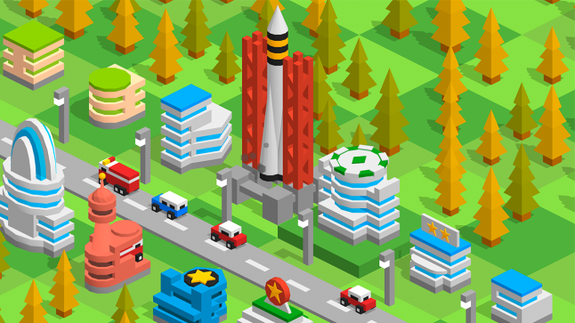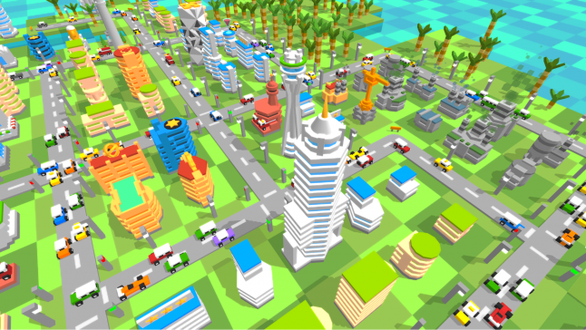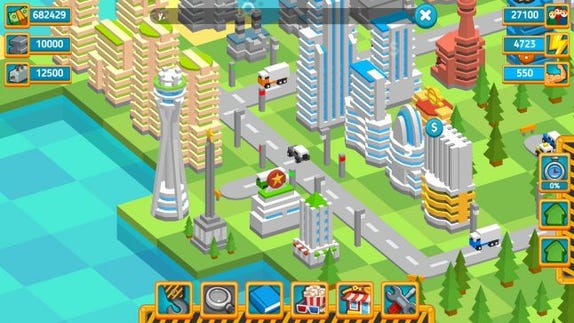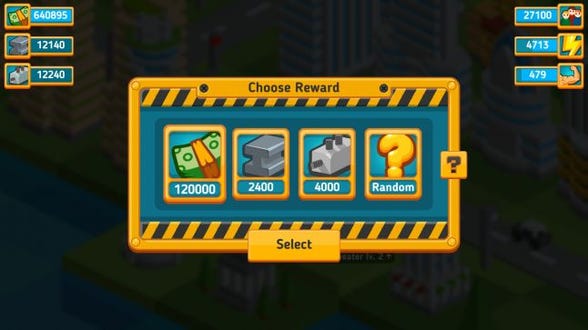Trending
Opinion: How will Project 2025 impact game developers?
The Heritage Foundation's manifesto for the possible next administration could do great harm to many, including large portions of the game development community.

Featured Blog | This community-written post highlights the best of what the game industry has to offer. Read more like it on the Game Developer Blogs or learn how to Submit Your Own Blog Post
Tap Tap Builder is a city builder with clicker elements, developed by Hippo Games and published by HeroCraft. In this article we talk about various ways in which we experimented with the game together.

Development
Tap Tap Builder is a city builder with clicker elements. Unity was chosen as the engine for the game due to ease-of-use and the ability to create 3D models without the aid of advanced software. The game went into development in May 2015, and had its basic functionality 3 months later. After working on performance optimization, Hippo Games decided to submit their project to Games Jam Kanobu 2016. The game got into a selection of interesting projects, and was noticed by us, HeroCraft. Our board of experts liked the art and the novel gameplay, and we offered them to help with publishing the game.

About the game
Tap Tap Builder’s main feature is its fusion with the clicker genre: in order to construct a building, the player must repeatedly tap the screen.
Beside the city-builder/clicker fusion, the game also had a classic RPG concept at its core: the player earns experience and levels up. For each level, they receive 1 Golden Key, the equivalent of a skill point. Golden Keys can be spent to construct special buildings which increase the city’s efficiency. They can, for instance, increase collected taxes by 20%, or boost population growth. It’s not hard to draw an analogy between such structures and an RPG skill system.
Another idea that was implemented was to distribute direct and indirect gameplay functions between buildings, better distinguishing each one. Thus, for example, you construct an Obelisk of Victory in order to participate in in-game rankings. Or a post office in order to send packages to other players. Consequently, the game doesn’t have a main menu where all functions would be accessible at once. Everything is unlocked gradually, which, it turns out, players found interesting.

Another idea that players liked was the Movie Theater (the building with the star in the picture below). The Movie Theater shows ads, while offering the player a choice of rewards. The player builds and upgrades the Movie Theater, and then holds opening nights there. Ads are, of course, an integral part of any movie screening. I.e. a typical way to monetize, but we find it has been built quite seamlessly into the gameplay.



Coupons are a mechanic for interaction between players. Based on the previous concept, it also shouldn’t require a network connection. Here’s how it works: each player gets a five-digit city postal code. To send a package, you have to choose what you want to send, and to whom. For instance, 10,000 credits to a player with the postal code 50890. The game will generate a five-character coupon—e.g.GJ6YP—which you can share with the recipient. Only the recipient will be able to decode that coupon.

Soft launch
In order to understand who’s doing what and who’s buying what, to have a real-time picture of player behavior the developer integrated Facebook, App Metrica, Amplitude, Tune, and Chartboost into the game. It’s common knowledge that you have to record and analyze all player actions in a game from the earliest stages of its life.
Tap Tap Builder’s soft launch period lasted from March to November 2016. During that time, the developer and we were adding final touches and polishing the game.
The first thing we did was increase performance by a factor of 10, so that the game now ran even on low-end devices. Second, based on the player data we’d gathered, we fine-tuned the game balance, doubling our retention rates. Third, we worked on the way we monetized the game, resulting in tripled revenue per user. We achieved that by introducing a system of regular bargain sales, held 2 or 3 times a month. Besides that, we’ve increased the bonus for watching rewarded videos and introduced mandatory ads for non-paying players (and those who didn’t watch the optional ads).
At the same time, we were adding new functions to the game: there were new buildings, more levels, and higher prices. In other words, we stretched the gameplay out with a 40-day period in mind. The game was showing excellent conversion into installs and virality. It was at that stage that we went into open beta on Google Play in May, implemented a number of important Google Play and App Store features, translated the game into 5 languages, and continued testing, analyzing, and making corrections. The release, scheduled for September, took a little longer, and the game was eventually launched on November 8. The total development time was thus about a year.
Incidentally, the game’s original title had been Tap Tap Town, but we had to abandon that since it was already taken on the App Store.
Interesting cases
1.The Icon
The game started out with a rather plain icon:
![]()
We began reworking the icon, bearing in mind that the game’s main audience is male (60% / 40%). Our first choice was therefore a picture of a girl; we decided to make two different versions. As a backup, we also drew a tough-looking construction worker in a helmet. Much to our surprise, the icon with the worker has so far had the best install conversion rates out of the three. We’re planning on improving it further.
![]()
This is what the “evolution” of the game’s icon looked like:

As you can see, there was also a provisional version of the construction worker, but it performed very poorly.
2. Game Design
Here’s an example of a major design overhaul we went through: initially, you could construct any building in the game. We recommended to add tutorial quests that would hint at the optimal buildings to construct early in the game, which would provide training instead of a frustrating multitude of options.
Then we added player levels and experience, with the player receiving gifts upon gaining a level, and the buildings in the game unlocking progressively with higher levels. In other words, the player had to level up before they could construct a particular building.
After that, we discussed two possible solutions. In the first one, you could construct the building you needed before gaining the appropriate level by spending premium currency; the second one did not offer that option. A/B tests showed that it was better not to give the player the option of unlocking buildings for premium currency; retention and revenue were 10–30% lower.
Release
In November 2016, the game was released on the App Store and Google Play, and has to date been downloaded a total of a million and a half times from these two platforms. We were able to get featured on the App Store at launch.

Featured on the App Store main page

Featured in Canada
A while later, Tap Tap Builder was featured on Google Play:

The game got some Western media coverage on TouchArcade and GameGrin. Tap Tap Builder also became a YouTube favorite, with let’s-plays and highlights in overview videos numbering around thirty.
Future plans
We are planning on expanding to further platforms, primarily Facebook and Vkontakte (Russian social media network). Beside that, we have plans to develop the game’s social component to allow players to interact more closely and earn in-game experience together.
Read more about:
Featured BlogsYou May Also Like